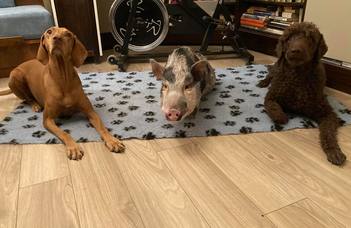Dogs are man’s, while pigs are only their owner’s best friend?

The study reveals that living in a human family is not enough for developing an early general human preference in companion animals, species differences weigh in.
species differences weigh in.
Dogs are known for being especially social with humans from a very early age. Even those with limited contact to humans readily approach and seek human proximity and dogs can also recognize familiar over unfamiliar humans. This special sociability of dogs has been assumed to be the result of both their domestication and socialization with humans during early development. “We were curious if being kept as a family member from a very early age, like dogs, would induce similar proximity-seeking behaviours towards their owner in another social domestic species, the pig”-explains Paula Pérez Fraga, first author of the study, PhD student at ELTE Department of Ethology.

Companion pigs at home (Photo: Balázs Somorjai)
Nowadays, the domestic pig, especially the miniature variant, is
a popular companion animal
that occupies a similar social niche in the human family as the family dog. This new role of the pig creates the need to better understand the pig-human relationship in the household environment, and especially the relationship of the pigs with their owners. “The miniature pigs that are part of our Family Pig Project are raised in human families since their 6-8 weeks of age. This does not only provide a unique opportunity to investigate the pig-human relationship, but it also allows us to directly compare their human-oriented behaviour to those of dogs” – says Attila Andics, principal investigator of the MTA-ELTE 'Lendület' Neuroethology of Communication Research Group.
This video summarizes the study
“In this study, the animals were led into a novel room, where their owner was paired with a familiar object or with an unfamiliar person, on two separate occasions. The subjects could freely choose to be anywhere in the room, e.g. staying near or further away from any of the humans or the object” – says Linda Gerencsér, research fellow at the Research Group.
“We found that both pigs and dogs preferred to stay near their owner over the familiar object. However, when a stranger was also present pigs and dogs behaved differently. Dogs preferred to stay near both humans over being elsewhere, whereas pigs rather stayed away from the social partners, which might reflect slight fear towards the unfamiliar human.” Interestingly, the research also revealed a difference in how the two species behaved near their owner. “Pigs needed more physical contact” – adds Pérez Fraga. “They touched the owner with the snout, in a similar manner as they do with conspecifics, and they climbed to the owner’s lap.”

Test setup (Photo: Paula Pérez)
This is the first study to investigate the proximity seeking behaviours of miniature pigs towards their owner. “The similar previous experience of both pigs and dogs might lead to a similar role of the owner for the two species” – adds Gerencsér. “However, being kept as a family member might not be enough for developing a general preference for human company in pigs.
Species predispositions, including that dogs, have a longer socialization period and humans are more salient as a social stimulus for them, might play an important role.”

